Henry Cloud's Blog, page 7
May 27, 2019
How to Set Limits on Yourself
 Sarah had been working on major boundaries issues in her therapy for a while now. She was seeing progress in resolving responsibility conflicts with her parents, her husband, and her kids. Yet today she introduced a new issue.
Sarah had been working on major boundaries issues in her therapy for a while now. She was seeing progress in resolving responsibility conflicts with her parents, her husband, and her kids. Yet today she introduced a new issue.
“I haven’t told you about this relationship before, though I guess I should have. I have tremendous boundary problems with this woman. She eats too much, and has an attacking tongue. She’s undependable — lets me down all the time. And she’s spent money of mine and hasn’t paid me back in years.”
“Why haven’t you mentioned her before?” I asked.
“Because she’s me,” Sarah replied.
Sarah was echoing the conflict most of us have. We learn that boundaries are biblical. We begin setting limits on others. We begin moving from taking too much responsibility to taking just enough. But how do we begin to set limits on ourselves?
Instead of looking at the control and manipulation of others, we also need to be looking at our responsibility to control our internal boundary conflicts. This can get a little touchy. But, instead of a defensive posture, we are much better off to look humbly at ourselves. To ask for feedback from others. To listen to people we trust. And to confess, “I was wrong.”
Since the Fall, our instincts have been to withdraw from relationship when we’re in trouble, when we most need other people. (Remember how Adam and Eve hid from God after they ate the forbidden fruit?) Due to our lack of security, our loss of grace, our shame, and our pride, we turn inward, rather than outward, when we’re in trouble. And that’s a problem. As Ecclesiastes 4:10 puts it, “Woe to one who is alone and falls and does not have another to help.”
Such withdrawal happens in our program time after time. For the first time, hurting people come forth with their need for connection. Like a rose lifting its petals after a hard rain, they begin to relate and connect in the light of the grace of God and his people. Then an unexpected setback will occur. Instead of bringing the painful and frightening feelings and problems to their newfound relationships, these people will often retreat to work out the problem alone.
It is only when this attempt at a solution breaks down that they finally realize that these spiritual pains and burdens need to be brought out of themselves to the body of Christ. Truly every person needs to feel very secure before she will risk taking her spiritual and emotional problems to other people.
________
Click to Tweet: Just as the branch withers without the vine, we can sustain neither life nor emotional repair without bonding to God and others.
________
And yet the Bible doesn’t recognize any other answer to our problems. Grace must come from the outside of ourselves to be useful and healing. Just as the branch withers without the vine, we can sustain neither life nor emotional repair without bonding to God and others. God and his people are the fuel, the energy source from which any problem is addressed.
Whether our boundaries issue is food, substances, sex, time, projects, the tongue, or money, we can’t solve it in a vacuum. If we could, we would. But the more we isolate ourselves, the harder our struggle becomes. Just like an untreated cancer can become life-threatening in a short time, self-boundary problems will worsen with increased aloneness. We need to the body of Christ to heal and to grow up.
________
Ready to go deeper on this topic? Discover how to set healthy limits in any situation and prevent unnecessary burdens from controlling your peace and energy in The New York Times bestselling book, Boundaries.
The post How to Set Limits on Yourself appeared first on Boundaries Books.
May 20, 2019
Why Responsible People Enable Irresponsible People
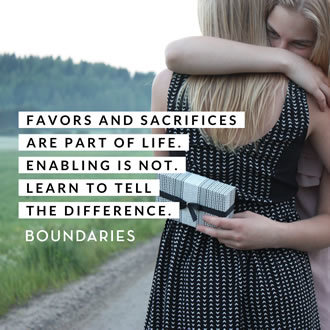 Susie was an administrative assistant in a small company that planned training sessions for different industries. She was responsible for booking the training sessions and managing the speakers’ schedules. Her coworker, Jack, was responsible for the training facilities. He took the materials to the site, set up the equipment, and ordered the food. Together, Susie and Jack made the events happen.
Susie was an administrative assistant in a small company that planned training sessions for different industries. She was responsible for booking the training sessions and managing the speakers’ schedules. Her coworker, Jack, was responsible for the training facilities. He took the materials to the site, set up the equipment, and ordered the food. Together, Susie and Jack made the events happen.
After a few months of really liking her work, though, Susie began to lose energy. Eventually, her friend and coworker, Lynda, asked her what was wrong. Susie couldn’t put her finger on the problem at first. Then she realized: The problem was Jack!
Jack had been asking Susie to “pick this up for me while you’re out,” or “please bring this box of materials to the workshop.” Slowly, Jack was shifting his responsibilities onto Susie.
“You have to stop doing Jack’s work,” Lynda told Susie. “Just do your own work and don’t worry about him.”
“But what if things go wrong?” Susie asked.
Lynda shrugged. “Then they’ll blame Jack. It’s not your responsibility.”
“Jack will be angry with me for not helping,” Susie said.
“Let him,” said Lynda. “His anger can’t hurt you as much as his poor work habits can.”
So Susie began to set limits on Jack. She told him, “I will not have time to bring the materials for you this week.” And when Jack ran out of time to do things himself, Susie said, “I’m sorry that you have not done that before now, and I understand that you are in a bind. Maybe next time you will plan better. That’s not my job.”
Some trainers were angry that their equipment was not set up, and customers were angry that no food was provided for the break. But the boss tracked down the problem to the person who was responsible — Jack — and told him to shape up, or find another job. In the end, Susie began to like work again, and Jack began to get more responsible. All because Susie set boundaries and stuck to them.
If you are being saddled with another person’s responsibilities and feel resentful, you need to take responsibility for your feelings, and realize that your unhappiness is not your coworker’s fault, but your own. As in any other boundaries conflict, you first must take responsibility for yourself.
Then you must act responsibly to your coworker. Go to your coworker and explain your situation. When he asks you to do something that is not your responsibility, say no and refuse to do whatever it is that he wants you to do. If he gets angry at you for saying no, be firm about your boundaries and empathize with his anger. Don’t get angry back. To fight anger with anger is to get hooked into his game. Keep your emotional distance and say, “I am sorry if this upsets you. But that job is not my responsibility. I hope you get it worked out.”
If he continues to argue, tell him that you are finished discussing it; he can come and find you when he is ready to talk about something else. Do not fall into the trap of justifying why you can’t do his work for him. You will be slipping into his thinking that you should do his work if you are able to, and he will try to find a way that you can. You owe no one an explanation about why you will not do something that is not your responsibility.
Many over-responsible people who work next to under-responsible people bear the consequences for their coworkers. Always covering for them, or bailing them out, they are not enjoying their work or their relationships with these people. Their lack of boundaries is hurting them, as well as keeping the other person from growing. If you are one of these people, you need to learn to set boundaries.
________
Click to Tweet: Favors and sacrifices are part of life. Enabling is not. Learn to tell the difference.
________
Sometimes, however, a coworker will genuinely need some extra help. It is perfectly legitimate to bail out a responsible coworker, or to make special concessions to a colleague who uses those concessions responsibly to get well. This is love, and good companies operate lovingly. But if one person started taking advantage of the other, that would need to stop. Covering for the other at that point would not be helpful, but would enable a bad pattern.
Favors and sacrifices are part of life. Enabling is not. Learn to tell the difference by seeing if your giving is helping the other to become better or worse. Require responsible action out of the one who is given to. If you do not see it after a season, set boundaries.
________
Ready to go deeper on this topic? Discover how to set healthy limits in any situation and prevent unnecessary burdens from controlling your peace and energy in The New York Times bestselling book, Boundaries.
The post Why Responsible People Enable Irresponsible People appeared first on Boundaries Books.
April 24, 2019
How to Move from Stuckness to Success by Dr. John Townsend
 All of us want to be a success in life. We want a career that is fulfilling and that creates a sustainable lifestyle. We want relationships and family connections that are warm and intimate. We want to give back in service to the world in some way. Yet so often, we find ourselves stuck, in getting from where we are, to where we want to be.
All of us want to be a success in life. We want a career that is fulfilling and that creates a sustainable lifestyle. We want relationships and family connections that are warm and intimate. We want to give back in service to the world in some way. Yet so often, we find ourselves stuck, in getting from where we are, to where we want to be.
If you have found yourself stuck instead of successful in some area of life, it is likely that there is some sort of a problem in your being free to make the choices you need to make. That is, you may not be executing the right boundaries to help you move forward. When you set healthy boundaries in the right way, really good things can happen. What follows are three tips to help you move from stuck to successful.
Determine What You Want Versus What Others Want from You
This is a critical boundary to set. Often, we think of what others expect before we know what we really want in life. Yet the Bible tells us to make choices all the time, for example who we worship: “…choose for yourselves this day whom you will serve” (see Joshua 24:15). So get a piece of paper and write what you want to happen: a career goal, a relationship problem solved, a financial dream or a health goal. It does matter what people think, and we do impact others. Take those into consideration. But start with your own goal and desire and work from there.
Say No to the Good and Yes to the Right
Most of us don’t have major issues saying no to really toxic influences like drugs or crime. We aren’t supposed to do those things in the first place! But it is trickier to say yes to those things that aren’t inherently bad, but take time and energy from what you want. We can’t do everything, so we have to say no to good things to get to the right things. For example, you may need to decline your involvement on a committee because you can’t get to your own goals. Or you may need to tell a friend you can’t talk on the phone as frequently as you would like, because you don’t have the time. These aren’t fun decisions. But they free you up to work on that goal or relationship.
________
Click to Tweet: Say no to the good and yes to the right.
________
Have Conversations with People Who Are Operating Against You
There are, unfortunately, people who can be controlling, negative, judgmental or hurtful with you. This is such a power drain, how can you move from stuckness to success when you have their influence deflating your passion? Good boundaries mean having a loving but direct talk with some key people, in which you say, in effect, “I care about you and us, but your behavior makes it difficult for me to be around you. I would like to see some changes in our relationship, otherwise I will need to make some distance, which I don’t want.” The book How to Have That Difficult Conversation will help you with this issue.
Jesus taught us to let our yes be yes, and our no be no (see Matthew 5:37). Growth research, high performance research, and our own experience show that His words are true and that they work. Here’s to your own movement from stuckness to success!
________
Start Taking Control of Your Life!
Get the FREE PDF eBook The 10 Laws of Boundaries by subscribing to the Boundaries Weekly email newsletter. LEARN MORE
The post How to Move from Stuckness to Success by Dr. John Townsend appeared first on Boundaries Books.
April 23, 2019
Raising Kids with an Eye on the Future
 It was a normal day, but one that would forever change my friend’s parenting. We had finished dinner, and I (Dr. Cloud) was visiting with my friend, Allison, and her husband, Bruce, when she left the dinner table to do some chores. Bruce and I continued to talk until a phone call took him away as well, so I went to see if I could lend Allison a hand.
It was a normal day, but one that would forever change my friend’s parenting. We had finished dinner, and I (Dr. Cloud) was visiting with my friend, Allison, and her husband, Bruce, when she left the dinner table to do some chores. Bruce and I continued to talk until a phone call took him away as well, so I went to see if I could lend Allison a hand.
I could hear her in their 14-year-old son Cameron’s room. I walked in to a scene that jolted me. She was cheerfully putting away clothes and sports equipment and making the bed. She struck up a conversation as if things were normal: “I can’t wait for you to see the pictures from our trip. It was so much—” “What are you doing?” I asked. “I’m cleaning up Cameron’s room,” she said. “What does it look like I’m doing?” “You are what?” “I told you. I’m cleaning up his room. Why are you looking at me like that?” All I could do was to share with her the vision in my head. “I just feel sorry for Cameron’s future wife.”
Allison straightened up, froze for a moment, and then hurried from the room. I walked into the hall to see her standing there motionless. Not knowing what to say, I said nothing. After a few moments, she looked at me and said, “I’ve never thought about it that way.”
Nor have most of us. We parent in the present without thinking about the future. We usually deal with the problems at hand. But one goal of parenting is to keep an eye on the future. We are raising our children to be responsible adults. Parents interact with their children in a way that comes naturally to them.
________
Click to Tweet: You are preparing your child for the future, and a person’s character is one’s destiny.
________
For example, Allison was by nature a “helper,” and she gladly helped her son. Others have different parenting styles. Some, who are more laid back and uninvolved, leave their son’s room alone. Those who are stricter inflict heavy punishment for a less than regulation-made bed.
Certainly, child rearing requires many different interventions. There are times for helping, for not getting involved, or for being strict. But the real issue is this: Is what you are doing being done on purpose? Or are you doing it from reasons that you do not think about, such as your own personality, childhood, need of the moment, or fears? Remember, parenting has to do with more than the present. You are preparing your child for the future, and a person’s character is one’s destiny.
Question for Reflection:
In what ways could you parent your son or daughter with a stronger focus on their future? What changes could you make this week to move in that direction?
________
Learn more about how to instill the kind of character in your children that will help them lead balanced, productive, and fulfilling lives in Boundaries with Kids.
The post Raising Kids with an Eye on the Future appeared first on Boundaries Books.
April 17, 2019
Boundaries Let the Good in and Keep the Bad Out
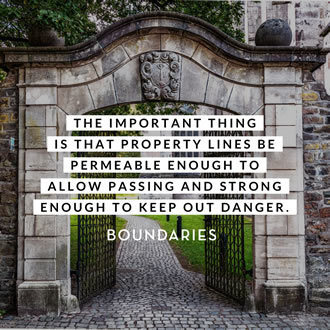 Boundaries help us to distinguish our property so that we can take care of it. They help us to “guard our heart with all diligence.” We need to keep things that will nurture us inside our fences and keep things that will harm us outside. In short, boundaries help us keep the good in and the bad out. They guard our treasures (Matt. 7:6) so that people will not steal them. They keep the pearls inside, and the pigs outside.
Boundaries help us to distinguish our property so that we can take care of it. They help us to “guard our heart with all diligence.” We need to keep things that will nurture us inside our fences and keep things that will harm us outside. In short, boundaries help us keep the good in and the bad out. They guard our treasures (Matt. 7:6) so that people will not steal them. They keep the pearls inside, and the pigs outside.
Sometimes, we have bad on the inside and good on the outside. In these instances, we need to be able to open up our boundaries to let the good in and the bad out. In other words, our fences need gates in them. For example, if I find that I have some pain or sin within, I need to open up and communicate it to God and others, so that I can be healed. Confessing pain and sin helps to “get it out” so that it does not continue to poison me on the inside (1 John 1:9; James 5:16; Mark 7:21 – 23).
And when the good is on the outside, we need to open our gates and “let it in.” Jesus speaks of this phenomenon in “receiving” him and his truth (Rev. 3:20; John 1:12). Other people have good things to give us, and we need to “open up to them” (2 Cor. 6:11 – 13). Often we will close our boundaries to good things from others, staying in a state of deprivation.
________
Click to Tweet: The important thing is that property lines be permeable enough to allow passing and strong enough to keep out danger.
________
In short, boundaries are not walls. The Bible does not say that we are to be “walled off” from others; in fact, it says that we are to be “one” with them (see John 17:11). We are to be in community with them. But in every community, all members have their own space and property. The important thing is that property lines be permeable enough to allow passing and strong enough to keep out danger.
Often, when people are abused while growing up, they reverse the function of boundaries and keep the bad in and the good out. When Mary was growing up she suffered abuse from her father. She was not encouraged to develop good boundaries. As a result, she would close herself off, holding the pain inside; she would not open up to express her hurt and get it out of her soul. She also would not open up to let support from the outside in to heal her. In addition, she would continually allow others to “dump” more pain into her soul. Consequently, when she came in for help, she was carrying a lot of pain, still being abused, and “walled off” from support from the outside.
She had to reverse the ways her boundaries worked. She needed fences that were strong enough to keep the bad out and gates in those fences to let out the bad already in her soul and let in the good she desperately needed.
________
From Boundaries by Dr. Henry Cloud and Dr. John Townsend. Click here to learn more about this New York Times bestseller.
The post Boundaries Let the Good in and Keep the Bad Out appeared first on Boundaries Books.
April 15, 2019
My Teen Is on Drugs. What Can I Do?
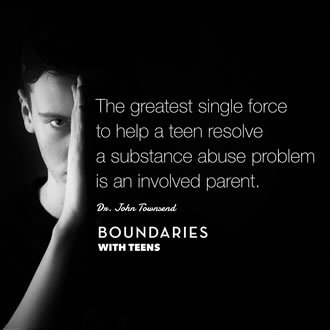 It’s every parent’s nightmare: having a teen on drugs. This is not life as God designed it. Substance abuse causes the breakdown of all that is good. Enslavement replaces freedom. Detachment replaces love. Chaos replaces order. Despair replaces hope.
It’s every parent’s nightmare: having a teen on drugs. This is not life as God designed it. Substance abuse causes the breakdown of all that is good. Enslavement replaces freedom. Detachment replaces love. Chaos replaces order. Despair replaces hope.
Many young people abuse alcohol and drugs, and this problem is not likely to go away anytime soon. I (Dr. Townsend) can’t overstate the danger of substance abuse. It can, and often does, lead to poverty, injury, disease, and death.
But despite the seriousness of this problem, parents of teens with this issue need to understand that the greatest single force to help a teen resolve a substance problem is an involved parent. What follows are some guidelines for the process.
Defining the Problem
Unfortunately, the teen years are a perfect fit, in a sick way, for substance abuse problems. By nature, adolescents challenge the authority and values of parents and are highly susceptible to peer approval.
They are interested in feelings and experiences, often to the neglect of good judgment, yet they can quickly become disconnected and can feel isolation deeply. Teens get easily bruised, discouraged, and hurt, and they gravitate toward quick ways to medicate the pain. No wonder the issue has become so far-reaching, particularly now that drugs are so accessible.
And they are accessible. Your teen likely knows how to get drugs if he wants them. He knows someone, or knows someone who knows someone. Be wise. Keep your head out of the sand and assume your teen has access.
If you accept this reality, it can assist you in helping your teen stay away from alcohol and drugs or in helping him recover from them.
Handling the Problem
You can’t control whether your teen has access to drugs and alcohol, but you can support him and help him develop the internal restraints and strength he needs to resist using substances. Here are some ways to do just that.
Establish a zero tolerance policy. Be clear with your teen that substances are not acceptable and that you will not tolerate them. Your adolescent may be hearing muddy messages from lots of other sources, including friends and some of their parents. This is a black-and-white issue, not a gray one, so be direct about your stance on alcohol and drugs.
________
Click to Tweet: The greatest single force to help a teen resolve a substance problem is an involved parent.
________
Not only should you be forthright about your stance, but also about the consequences. Let your adolescent know ahead of time that if she uses drugs or alcohol, she will lose many valued privileges and freedoms. Not only that, but if your teen continues to use, she will have to live somewhere else, because you have a value that substance abuse will not be tolerated in your home.
I know parents who have sent their teens to a different high school to get away from drug-using friends. I know some who have sent their kids to boarding schools. Others have sent their kids to residential treatment centers. And still others have done everything they could until the teen reached majority age, and then they made her move out of the house. Many times, this was absolutely the right move to make. Such consequences may sound harsh, but only to those who are not experienced in the power and severity of drug problems. Substances are stronger than many people think, and their hold gets worse over time.
Come down hard at the first offense. If it is your teen’s first offense, resist the impulse to say, “Oh well, first time, just don’t do it again.” You will have only one first offense to deal with, and it is an opportunity to let your teen know that drugs and alcohol are not a casual deal. Otherwise, your teen may think it’s acceptable for him to use now and then.
Here are five suggestions for consequences:
Grounding. Grounding is a natural consequence, as your teen has shown that she can’t resist temptation with her friends, so she can’t have social contact with them for a significant period of time.
Supervised social contact. Allow your teen to go to social outings, including movies and parties, but only with an approved parent present. If he does not use substances during this period, he can then have more social freedom.
Drug testing. Home drug tests are now readily available. You can tell your teen that for the next few months you will be testing her randomly. A side benefit is that this also gives your teen an excuse not to use with friends. She can say, “I can’t smoke pot. My parents do random testing.”
Legal education. Some counties offer training for families in which they take teens through the court system as if they were going to jail, so that they can experience what the system would be like were they to be arrested and tried on a drug charge.
Service. Have your teen help out at the local rescue mission or church, doing errands, stocking the warehouse, or cleaning up. Learning the value of service often helps adolescents become open to the needs of others and can help break the self-absorption of substance use.
Live in the Light
Our natural inclination as parents is to give our kids the information on the dangers of drugs and then hope they make good choices. But this is not enough. While your teen needs the information, she also needs you. She is not likely to say, “Would you ask me if I’m on drugs or not?” So be the parent and ask. Teens often hope on some level that their parents will ask, because they are scared and want to talk, but they are not about to ask a parent. Take the initiative to bring out drug matters into the light of relationship.
Listen when your teen talks. Try to get to the heart of what she understands, experiences, does, and feels. If you can’t be shocked, you will be more likely to get more information. Your teen needs your viewpoint, but she also needs your ears.
Sometimes parents avoid talking about alcohol and drugs beyond the basic “don’t do it” lecture. They think they might convey approval to the teen if they act interested in what is going on with friends and at school. Nothing could be further from the truth. Your teen is living in a drug-influenced world, whether or not she is using them. Don’t leave her alone in that world. Enter it, be curious about it, and get to know it. Find out what kids are using and where, which parents are lax about substances, and where the parties are. Your involvement doesn’t mean that you approve of drugs. It simply means you love your kid enough to get into her world.
Of course, being connected means more than talking about drugs. It involves being in an ongoing relationship with your teen about all aspects of her life. The more you connect on all levels, the more likely your teen will talk with you about any substance problem.
Know Your Teen
The better you know your adolescent, the better you will know how to respond to substance problems. Get to know what vulnerabilities are particular to your teen that drugs and alcohol might exploit, and get your teen the support, assistance, and structure he needs so that he is not so susceptible. Here are some common vulnerabilities and ways you can deal with them:
She challenges your parenting and values. Find ways to have her safely question you that don’t involve substances. Give her room and space to not be your clone.
He surrenders judgment to feelings and experiences. Spend time talking with him about that. Validate his need for experience, but help him develop the ability to make sound decisions, to think about the effects of his actions, and to postpone gratification for a greater good.
She is easily influenced by the approval of peers. Strengthen her individuality and character. Help her to say no to others, including you. Find healthy peers who will support her in this effort.
He is vulnerable to others. Have him make you the bad guy until he is stronger. For example, your teen may not be able to say, “No, I don’t do drugs,” but he can say, “My parents are really strict, and they would come down so hard on me if I did that.” Not only is this statement true, but it gives your kid an out until he is firmer in his own values.
She disconnects and isolates quickly. Take initiative and draw her out. Be a bridge between your teen and her feelings, between herself and the world. Help her reconnect so that she doesn’t need substances to feel alive.
He is easily hurt and is vulnerable to attempts to cover up his pain. Comfort and support your teen so that he can connect his hurt feelings to you so that they are less intense. At the same time, help him learn to confront and be honest with others so that he is stronger inside and less vulnerable.
More than ever before, your teen needs you to know who he is. Find out what he needs, what hurts him, and what matters to him. He may resist you, but part of him wants his parent to break through at some level so that he is not alone with himself.
Remember the Druggies
In all likelihood, you were around drugs or at least had friends who were druggies when you were a teenager. Remember what potential they had? Some were smart, funny, creative, and gifted. Now think about where many of those people are today. Is that what you want for your teen’s future? If your child’s present is substance-influenced, it can easily become a substance-dominated future.
Seek Help
If your teen is using alcohol or drugs, seek help. This complex problem requires much expertise, skill, and training. Fortunately, there are good counselors and teen workers who are well trained in substance problems. A good adolescent therapist can evaluate the severity of the problem and determine what structures will help the teen, ranging from counseling to an intensive detox and rehab program.
If your teen’s drug and alcohol usage has moved beyond experimentation and become a regular part of her life, she now has a dependency. She now uses substances compulsively, no matter how negative the life consequences have become. She cannot stop on her own and will need outside support and expertise.
Watch Out for Other Types of Dependency
Dependencies are not limited to drugs and alcohol. A teen can become a sex addict, for example, from viewing pornographic websites, and be trapped in compulsive behaviors that keep him returning to the sexual images.
These teens feel intense shame, guilt, and helplessness about their porn addictions. Youth pastors and counselors can do much to help kids deal with this issue.
In addition, some teens also have food dependencies known as eating disorders, such as anorexia, bulimia, and obesity. In such instances, eating habits and food intake become the focus of life, sometimes to the point of being life-threatening. Teens with these dependencies can make good progress in resolving them when they receive competent help.
You Can Do It!
Be proactive, informed, and involved. The sooner you deal with your teen’s abuse of alcohol, drugs, sex, or food, the more likely your teen will get back on the road to a healthy life. Your involvement can save your child’s life.
________
Read more about how to handle hot button topics effectively with a teen son or daughter in Boundaries with Teens.
The post My Teen Is on Drugs. What Can I Do? appeared first on Boundaries Books.
April 12, 2019
Why Do Nice People Attract Jerks?
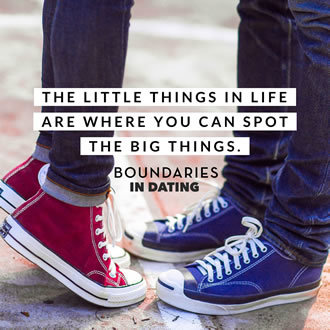 The question that many people wonder is “If I’m nice, then why do I keep attracting such jerks?” They think that something is inherently wrong with them, and sometimes they can begin to get quite hopeless over their chances of finding good friends, someone good to date, or building a great marriage.
The question that many people wonder is “If I’m nice, then why do I keep attracting such jerks?” They think that something is inherently wrong with them, and sometimes they can begin to get quite hopeless over their chances of finding good friends, someone good to date, or building a great marriage.
The key to remember is that the reason why nice people attract jerks is that they are too adaptive in the beginning. If that person had had boundaries, the problem never would have happened. Or if it did, the problem would have been fixed first.
People who are selfish and controlling can only be that way if they are in relationship with someone who is adaptive. If someone stands up to them and is honest about his or her wants and desires, then the controlling person has to learn to share or gets frustrated and goes away. Take these steps to avoid ending up in relationships that attract unhealthy people:
Be honest about your preferences and desires.
Don’t act like you like things other people like just so that you will be accepted.
Being liked for who you are requires that you be that person.
Tell the truth about where you want to go and not go, or what you want to do or not do.
Don’t be afraid to share your desires and wants for fear of conflict. Find out early if you are with someone who can share equally.
Get feedback from honest friends to tell you if you are really being yourself and seeing the relationship realistically.
Remember with each decision that you make you are giving the other person an impression of what you like in life and in a relationship. Be careful—he or she might believe you.
When you give or serve, let it be honest and purposeful.
You are a person, and you cannot go throughout life without pursuing your own wishes, needs, and desires, nor should you. Your needs and desires are going to come out, and you had better find out early in a relationship where the person really stands with the idea of sometimes having to adapt to them. You don’t want to be telling some counselor the following things ten years from now:
She seems to have to have her way.
I am afraid to let my real feelings and desires be known.
We have so much conflict over such little things.
We always spend our money on what he wants.
She doesn’t care about me and what I want.
Why can’t he ever go to the places that I want to go to?
Issues like these are usually discovered later in a relationship where one person has adapted for a long time, and then tries to make a change. The lesson is to be yourself from the beginning, and then you can find someone who is authentic as well. A relationship like that has mutuality and partnership. It has give and take. It has equality. It has sharing and mutual self-sacrifice for the sake of the other and the relationship.
________
Click to Tweet: The little things in life are where you can spot the big things.
________
If you are a real person from the start, a relationship of mutuality has a chance of developing. If you are not, then you might be headed for trouble.
The little things in life are where you can spot the big things. If you are with a self-centered person who cannot give to your desires, you will find out soon enough by being honest and straightforward about simple things, for that is where day-to-day life is lived. You will quickly find out if you are with someone who is able to share, or someone who has to have his or her way all the time. This knowledge will be helpful now and essential for the future.
________
Get more helpful advice to build the best dating relationship and find the love of your life by reading Boundaries in Dating.
The post Why Do Nice People Attract Jerks? appeared first on Boundaries Books.
April 5, 2019
How We Use Boundaries to Protect Our Love Story
 By Jeremy Roloff
By Jeremy Roloff
Editor’s Note: More than 2.3 million people watched as Jeremy and Audrey Roloff shared their vows and committed their lives to each other. Now for the first time, the former co-stars of TLC’s hit show Little People, Big World share their imperfect, resilient, and inspiring love story in their new book A Love Letter Life. What follows is an excerpt from the book.
Authors Henry Cloud and John Townsend define a boundary as “a property line.” One of the functions of healthy boundaries is to protect the “property” of our relationship from trespassing. In Boundaries in Marriage, Cloud and Townsend write, “While many dynamics go into producing and maintaining love, over and over again one issue is at the top of the list: boundaries. When boundaries are not established in the beginning of a marriage, or when they break down, marriages break down as well . . . For this intimacy to develop and grow, there must be boundaries.”
As Audrey and I entered into marriage, we knew that the locomotive of our love would not stay on track without boundaries. Boundaries are the protective rail lines of our love. Boundaries are designed to protect, not prohibit. For example, a ski boundary line, a divider on a freeway, directions on the back of a medication bottle—these boundaries are not set in place to hold us back; they are set in place to safeguard us.
Boundaries in marriage are no different. Their purpose is to protect our marriages from division, hurt, bitterness, animosity, and miscommunication. Early on in our marriage, Audrey and I were encouraged to protect our love by setting boundaries for our finances, our friendships, and our technology—specifically social media.
I believe that the overuse of social media is posing a massive threat to our love stories. It can be a tempting place to zone out, escape, or invite wandering eyes. It can allow comparison to steal the joy that our love stories were meant to experience. It can steal our time, causing us to spend more of it scrolling feeds than connecting with our loved ones. Without boundaries for phone and social media use, we’ll lose our grip on what it means to truly connect.
Here are a few of the boundaries we use to protect our love story:
We don’t use social media on Sunday.
We don’t check our phone during date night.
We don’t get on our phones in bed.
We have access to each other’s social media accounts.
We don’t go out one-on-one (coffee/drinks) with the opposite sex.
We don’t keep texts, emails, or social media messages to the opposite sex a secret.
We don’t text old boyfriends/girlfriends without the other knowing about it.
We encourage you to come up with your own list of boundaries. It doesn’t need to be exhaustive, nor does it need to be completed overnight. Just begin the conversation for the sake of protecting your love.
________
Taken from A Love Letter Life: Pursue Creatively, Date Intentionally, and Love Faithfully by Jeremy and Audrey Roloff. Visit aloveletterlife.com to learn more about this title.
Jeremy Roloff grew up on a 110-acre farm in Helvetia, Oregon, alongside his twin brother and two younger siblings. Jeremy helps his parents, who are both dwarfs, run Roloff Farm’s pumpkin patch, which brings in thousands of visitors from around the world every weekend in October. Jeremy has a degree in professional photography and is the cofounder of Beating50Percent.com, a marriage ministry on mission to revive covenant marriages. He also grew up filming for a reality television show called Little People, Big World, which has been following his family since he was fourteen years old. He is a 9 on the enneagram, loves old cars, and will never pass up an evening by the campfire.
The post How We Use Boundaries to Protect Our Love Story appeared first on Boundaries Books.
March 29, 2019
This One Belief Can Predict Success
 It was the Fourth of July and I (Dr. Cloud) was at a celebration that included a memorial “paddle out” on surfboards in the Pacific Ocean to honor and remember my brother-in-law, Mark. He was a Navy SEAL, a great American, husband, father, hero, brother, and a friend. Mark died on a mission in Iraq in 2008.
It was the Fourth of July and I (Dr. Cloud) was at a celebration that included a memorial “paddle out” on surfboards in the Pacific Ocean to honor and remember my brother-in-law, Mark. He was a Navy SEAL, a great American, husband, father, hero, brother, and a friend. Mark died on a mission in Iraq in 2008.
My ten-year-old daughter Olivia, wanted to participate in the paddle-out to honor her uncle. So, we borrowed a surfboard and began to walk out to the beach where the surfers were gathering, with me carrying the board. I was excited for her to take part in honoring her uncle Mark and was inspired by her fearlessness in wanting to paddle way out into the ocean with all the adults. She did just great and when we came back to the beach we hugged.
She was very proud and thankful for her uncle Mark and we spent a moment talking about all of it before everyone gathered their things to make the long walk back up the hillside to the main event. Everyone, that is, except Olivia and a few other people who had decided to go back into the ocean and catch some waves.
She said to me, “Daddy, I want to stay here and go back out. I will come up and join you guys later.”
“No, Livi. I’m sorry but you can’t. Who will walk back up with you? You can’t walk all the way back by yourself with just your cousin. Sorry,” I said. I did not want her in the commotion by herself at her age, and also, there was no way that she could get that big surfboard all the way back uphill.
“But it’s fine, Daddy,” she said. “There are some adults coming too, and they have to walk back. I will walk with them.”
“No, Livi, just come with me now. It will be a lot less complicated,” I said. Then I played my trump card. “Besides, the surfboard is way, way too heavy for you to carry back. They all have their boards and won’t be able to carry it for you, and I can do that if you come now. If you don’t come with me, how would you ever get it back up the hill?” At this point, I thought I had her.
“Dad!” she said forcefully. “I WILL find a way.”
Those words pierced my heart. I literally had to stop talking as I felt tears welling up in my eyes. It was true: she would FIND a way. Because that’s who she is. The tears I felt were more than just a moment of being proud of her. The tears were that I literally, and I mean literally, felt something happen inside of me. At that moment, I somehow got assured of her future in life.
As a psychologist, I know that there are two kinds of people in the world. People whose circumstances overcome them, and people who overcome their circumstances. As the psychologist, I did not just hear “I will find a way to get the surfboard back.” I heard something automatically coming from her innermost being, from the operating system that made her who she was—the kind of person who says, “I will find a way.”
________
Click to Tweet: A belief that one will be successful is one of the strongest predictors of goal achievement.
________
I knew that mode of thinking would serve her for life, no matter what her future circumstances might be. I knew that she will always “find a way.”
“OK, Livi,” I said. “Have fun.”
“Bye, daddy.” and she waved as she ran to join the group. I did not worry one iota, and in a couple of hours, she and the big heavy surfboard were back where they belonged.
Research has revealed time and again that a belief that one will be successful is one of the strongest predictors of goal achievement. Great leaders build this belief into their people, teams, and culture. They believe that they can do it, and when things get tough, they find a way. They exert what I call “optimistic control,” even in environments where there are many negative realities that they cannot control.
________
Taken from Boundaries for Leaders by Dr. Henry Cloud. Learn more about this incredibly helpful book.
The post This One Belief Can Predict Success appeared first on Boundaries Books.
March 24, 2019
Your Child’s Pain Should Not Control Your Actions
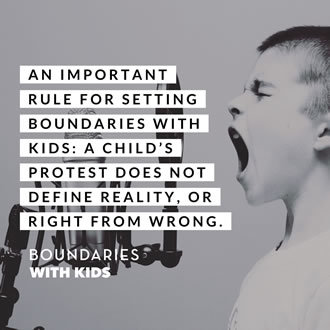 Boundaries with kids begins with parents having good boundaries of their own. Purposeful parents stay in control of themselves. If your child is controlling your decisions by protesting your boundaries, you are no longer parenting with purpose.
Boundaries with kids begins with parents having good boundaries of their own. Purposeful parents stay in control of themselves. If your child is controlling your decisions by protesting your boundaries, you are no longer parenting with purpose.
Terri was having problems with her thirteen-year-old son Josh not doing his homework. I helped her come up with a plan that would require Josh to set aside a certain time each night to do homework. During this hour Josh had to be in his study place with nothing else but his work, and he was not to do anything else but study. Terri had no control over whether or not Josh actually chose to study during that time. What she could control was that he do nothing else during that time but sit with his homework.
When I saw her the next time, Terri looked sheepish. She had not lived up to her end of the plan. “What happened?” I asked. “Well, we were all set, and then he got invited to go to a baseball game with his friend. I said no, that his hour was not up yet. But he got so upset, I could not talk him out of it. He seemed so mad and sad.”
“So,” I said, “that’s what he’s supposed to do, remember? He hates discipline. So what did you do next?”
“Well, I could see that this requirement was just making him too sad, and I could not stand it. So I let him go.” (Clue number one that a child will not develop self-control is when the parent does not have self-control in enforcing the rules.)
“What happened the next night?” I asked, already knowing the answer.
“He got upset again. It was a similar situation. He had an opportunity that would have been very sad to miss.”
“So let me get this straight. The way you are deciding what is right or not is by how he feels when he is required to do something. If he is upset, then you think it is the wrong thing to do. Is that right?”
“I haven’t thought about it that way, but I guess you’re right. I just can’t stand for him to be sad.”
“Then you have got to come to grips with a few important truths. One, your values are being set by the emotional reactions of an immature thirteen-year-old. Your value system’s highest guiding principle is whether or not Josh is upset. Two, you don’t value one of the most important aspects of child rearing: Frustration is a key ingredient to growth. The child who is never frustrated never develops frustration tolerance. Three, you are teaching him that he is entitled to always be happy and that all he has to do to get others to do what he wants is to cry about it. Are these really your values?”
________
Click to Tweet: An important rule for setting boundaries with kids: A child’s protest does not define reality, or right from wrong.
________
She grew silent and began to realize what she was doing. To change, she had to commit to an important rule for setting boundaries with kids: A child’s protest does not define reality, or right from wrong. Just because your child is in pain does not mean that something bad is happening. Something good may be occurring, such as his coming to grips with reality for the first time. And this encounter with reality is never a happy experience. But if you can empathize with the pain and hold on to the limit, your child will internalize the limit and ultimately get over the protest.
This is a law of the universe. Frustration and painful moments of discipline help a child learn to delay gratification, one of the most important character traits a person can have. If you are able to hold the limit and empathize with the pain, then character will develop. But if you don’t, you will have the same battle tomorrow. If you rescue your children from their anger at your boundary, you can plan on more anger at later limits. Remember, their protest or pain does not determine what is good.
________
Learn how to instill the kind of character in your children that will lead to a balanced, productive, and fulfilling life in Boundaries with Kids.
The post Your Child’s Pain Should Not Control Your Actions appeared first on Boundaries Books.



